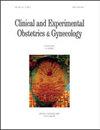Integration of Intraoperative Neurophysiological Monitoring into Laparoscopic Pelvic Nerve Decompression Surgery: A Novel Technique for Protecting Pelvic Nerves
IF 0.6
4区 医学
Q4 OBSTETRICS & GYNECOLOGY
引用次数: 0
Abstract
Background: This study aims to present a novel technique that integrates intraoperative neurophysiological monitoring (IONM) into laparoscopy for continuous monitoring of pelvic nerves at risk during surgery to ensure their protection. Methods: This is a prospective analysis of 10 consecutive patients receiving surgical treatment for proven diagnosis of lumbosacral plexus nerve entrapment. Patients with symptoms of chronic pelvic pain, dyspareunia, dysmenorrhea, and severe, burning sharp pain on the lower extremity dermatomes were included. Laparoscopic decompression of lumbosacral plexus nerve entrapment with intraoperative neuromonitoring was performed between January 2021 and February 2022. Intraoperative neuromonitoring records (spontaneous electromyography (EMG), free-run EMG recordings, transcranial electrical motor-evoked potentials (TcMEP) recordings, direct nerve root stimulation recordings, and compound muscle action potentials (CMAPs) recordings) and preoperative and postoperative pain symptoms at one month were analyzed. Results: The median age of the patients was 29 (25–44) years. Neurovascular conflict, fibrosis, and abnormal piriformis muscle were identified as the three main etiologies of nerve entrapments. There were no statistically significant differences in transcranial motor evoked potential responses on the operated extremity side before and after decompression surgery or in the amplitude difference changes of TcMEP responses between the operated and non-operated extremity sides (p > 0.05). Dyspareunia visual analogue scale (VAS) scores showed a significant decrease at the first month postoperatively (p-value = 0.027). Conclusions: Integrating intraoperative neurophysiological monitoring into laparoscopy facilitates the monitoring of the patient’s motor function and prevents both permanent and transient nerve damage during pelvic nerve decompression surgery. This technique holds promise in enhancing surgical safety and preserving pelvic nerve function. The study was registered at https://clinicaltrials.gov (registration number NCT06009640).术中神经生理监测与腹腔镜盆腔神经减压术的结合:一种保护盆腔神经的新技术
背景:本研究旨在介绍一种将术中神经生理监测(IONM)与腹腔镜结合的新技术,用于术中对盆腔危险神经的持续监测,以确保其得到保护。方法:这是一项前瞻性分析,连续10例接受手术治疗的确诊腰骶丛神经卡压的患者。包括慢性盆腔疼痛、性交困难、痛经和下肢皮节严重灼痛的患者。2021年1月至2022年2月,在术中神经监测下进行腹腔镜腰骶丛神经压迫减压。分析术中神经监测记录(自发肌电图(EMG)、自由运动肌电图(free-run EMG)记录、经颅电运动诱发电位(TcMEP)记录、直接神经根刺激记录、复合肌肉动作电位(CMAPs)记录)及术前、术后1个月疼痛症状。结果:患者中位年龄为29岁(25-44岁)。神经血管冲突,纤维化和异常梨状肌被确定为神经卡压的三个主要原因。手术侧经颅运动诱发电位反应在减压手术前后及手术侧与非手术侧间经颅运动诱发电位反应振幅差变化无统计学差异(p >0.05)。术后1个月性交困难视觉模拟评分(VAS)明显降低(p值= 0.027)。结论:将术中神经生理监测整合到腹腔镜检查中,有利于对患者运动功能的监测,防止盆腔神经减压术中出现永久性和暂时性神经损伤。该技术在提高手术安全性和保护骨盆神经功能方面具有前景。本研究注册于https://clinicaltrials.gov(注册号NCT06009640)。
本文章由计算机程序翻译,如有差异,请以英文原文为准。
求助全文
约1分钟内获得全文
求助全文
来源期刊
CiteScore
0.50
自引率
0.00%
发文量
241
审稿时长
1 months
期刊介绍:
CEOG is an international, peer-reviewed, open access journal. CEOG covers all aspects of Obstetrics and Gynecology, including obstetrics, prenatal diagnosis, maternal-fetal medicine, perinatology, general gynecology, gynecologic oncology, uro-gynecology, reproductive medicine, infertility, reproductive endocrinology, sexual medicine. All submissions of cutting-edge advances of medical research in the area of women''s health worldwide are encouraged.

 求助内容:
求助内容: 应助结果提醒方式:
应助结果提醒方式:


